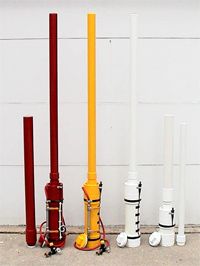Spud Gun Theory
The two basic types of spud gun -- combustive and pneumatic -- each use a rapidly expanding volume of gas to move a potato. Both types of guns are typically made of PVC pipe, although some people use acrylonitrile butadiene styrene (ABS), aluminum or other piping materials.
All spud guns have the same basic components:
Advertisement
- A chamber in which gas reaches a high pressure
- A barrel for the projectile
- Some type of firing mechanism
Typically, the sharpened end of the barrel acts as a barrel knife, which shaves off the excess potato during loading.
The method for creating high-pressure gas is what differentiates combustive and pneumatic spud guns. "A combustion-based spud gun," says Suprise, "uses a flammable vapor...you have a fuel-air mix in a chamber, and then you have an ignition source, typically an electric barbecue sparker, something of that nature, which will ignite that flammable mix." When the vapor ignites, the resulting explosion creates a large volume of hot gas, which forces the potato down the length of the barrel and out.
A pneumatic spud gun uses compressed air rather than flammable gas. Suprise explains:
In the next section, we'll examine the differences between combustive and pneumatic guns and how each generates the pressure needed to fire the potato.
